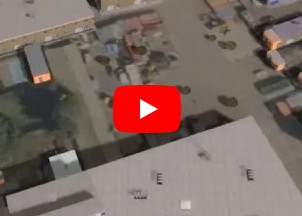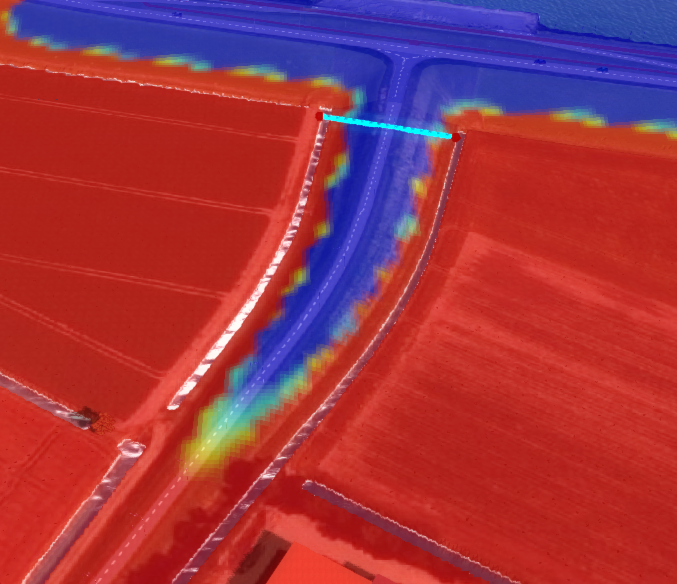|
|
| (109 intermediate revisions by 7 users not shown) |
| Line 1: |
Line 1: |
| {{stub}} | | [[File:GroundwaterOverlay2.png|left|thumb|200px|Groundwater overlay]] |
| | The Groundwater Overlay is a variant of the [[Water Overlay]], which in turn is a [[Grid overlay|grid overlay]]. Water overlays are connected to the [[Water Module]], a complex hydrological calculation module within the {{software}}. |
|
| |
|
| The groundwater overlay is an implementation of the [[Water model]] optimized for calculating the flow of underground watertables. This implementation focuses on water flowing at a low speed, and on the functioning of the water system without calamitous events such as [[Water model#Breach|breaches]]. | | The Groundwater overlay calculates and visualizes the movement of water underground and the resulting [[Ground watertable result type (Water Overlay)|watertable]]. |
|
| |
|
| ==Use cases==
| | In order to get more familiar with the different components of the Groundwater Overlay check out Quadrant 4 of the [[Testbed_water_module|Water Module Testbed]]. This Testbed is available to you as a project in the {{software}}. |
| The groundwater overlay can be used and is recommended when exploring the following use-cases:
| |
| * Modeling a static, low-speed water system
| |
| * Modeling the long-term effects of excessive rain or excessive drought on the water table
| |
| * Modeling the spread of chemicals through the underground, carried along by water
| |
|
| |
|
| ==Preparing to use the overlay== | | ==Groundwater overlay results== |
| To use the overlay, it is recommended that the project meets a number of prerequisites. Next, data can be prepared which define the functioning and flow of the water model. This includes a clear idea of what kind out output is desired. After that data is prepared, you can begin the actual steps of adding the overlay.
| | The Groundwater Overlay is a Water Overlay that is connected to the Water Module. This Water Module performs two dimensional grid based water simulations for a large set of input data and parameters, configured mostly through a related [[Water Overlay Wizard]]. When a simulation finishes, the module stores the result in the Groundwater overlay based on the selected result type. Only one result type can be stored per Groundwater overlay. |
|
| |
|
| It is important to model a fully functional static water system for any relevant use of the groundwater overlay. After setting up the static water model, additional effects can be modeled to account for special circumstances. This has the added benefit of creating a control-state, to which results of modifications or calamities can be compared.
| | The Water Module however, is not restricted to generating only one type of result. Instead it can produce multiple unique result types for one single simulation. |
| | Fortunately it is possible to add additional result type overlays which relate to a particular Groundwater overlay. These are known as [[Result Child Overlay]]s. Again, each child overlay only stores one particular result type. |
|
| |
|
| ===Prerequisites===
| | Apart from multiple result types, the Groundwater overlay can also store result data of multiple, intermediate simulation results, instead of just a single end result. These intermediate simulation results are known as [[timeframes (Water Overlay)|timeframes]]. |
| When creating your [[project]], make sure it meets the following [[Water model#Usage|criteria]]:
| |
| * Your project has been loaded in with a high-resolution DEM. This can be configured during the [[new project wizard]].
| |
| * Your project is large enough to account for edge effects. A buffer of at least 1km around your actual project area is recommended.
| |
| * The project's eventual use. The calculations will take longer than most other calculations in the {{software}}, so sessions with live interaction are discouraged.
| |
|
| |
|
| ===Data===
| | For the full list of result types, see [[Result type (Water Overlay)#List of Result Types|List of Result Types]]. |
| Before creating and configuring the overlay, it is best to prepare the data you wish to use in your model.
| |
|
| |
|
| ====Geo data====
| | For other results, which are not overlay results, but still related to the simulation for a particular Rainfall overlay, see [[Results (Water Overlay)|Groundwater overlay results]]. |
| The following data needs to be prepared, so that it can be loaded in and used by the water model's calculations:
| |
| {{OverlayChecklist|table=true}}
| |
| {{OverlayChecklist|Water areas|link=Water model#Water_area|
| |
| importance=Required|
| |
| description=Water areas set the water level of all open water in the area they envelop.}}
| |
| {{OverlayChecklist|Ground water|link=Water model#Groundwater_geotiff|
| |
| importance=Required|
| |
| description=The ground water geotiff sets the underground water level.}}
| |
| {{OverlayChecklist|Weirs|link=Water model#Weir|
| |
| importance=Required|
| |
| description=Weirs connect otherwise separate sections of open water, allowing water to flow over the weir.}}
| |
| {{OverlayChecklist|Culverts|link=Water model#Culvert|
| |
| importance=Required|
| |
| description=Culverts connect otherwise separate sections of open water, allowing water to flow through the culvert.}}
| |
| {{OverlayChecklist|Pumps|link=Water model#Pump|
| |
| importance=Required|
| |
| description=Pumps connect otherwise separate sections of open water, moving water unidirectionally from the lower terrain level to the higher terrain level.}}
| |
| {{OverlayChecklist|Inlets|link=Water model#Inlet|
| |
| importance=Required|
| |
| description=Inlets are points in the water model where water is added or removed from the hydrological system.}}
| |
| {{OverlayChecklist|Sewer areas|link=Water model#Sewer|
| |
| importance=Recommended|
| |
| description=Sewer areas intersect with [[sewered]] [[constructions]] in the area they envelop to form sewers which can store water.}}
| |
| {{OverlayChecklist|Sewer Overflows|link=Water model#Sewer_overflow|
| |
| importance=Recommended|
| |
| description=Sewer overflows allow water to flow from a sewer out into open water.}}
| |
| {{OverlayChecklist|table-end=true}}
| |
|
| |
|
| ====Calculation properties====
| | [[File:YoutubeLogo1.jpg|thumb|left|link=https://youtu.be/H0ewNjJ6P8c&feature=youtu.be|Improvements year round groundwater calculations.]]{{clear}} |
| Consider the duration you want your simulation to last, and whether you wish to account for rainfall in your model. The following environmental data needs to be prepared, so that it can be configured and used by the water model's calculations:
| |
| {{OverlayChecklist|table=true}}
| |
| {{OverlayChecklist|Simulation time|link=Water model#Simulation_time|
| |
| importance=Required|
| |
| description=How long should the simulation last in total.}}
| |
| {{OverlayChecklist|Timeframes|link=Water model#Timeframes|
| |
| importance=Optional|
| |
| description=How many result snapshots should be generated by the calculation, for inspection after the calculation completes.}}
| |
| {{OverlayChecklist|Rain|link=Water model#Weather|
| |
| importance=Optional|
| |
| description=How long should rain last at the start of the simulation, and how much rain should fall in total.}}
| |
| {{OverlayChecklist|table-end=true}} | |
|
| |
|
| ====Result types====
| |
| After the calculation completes, consider what kind of output is relevant to your use-case. The following [[Water model#Result_types|result types]] can be considered, so that it can be configured and used by the water model's calculations:
| |
| {{OverlayChecklist|table=true}}
| |
| {{OverlayChecklist|SURFACE_FLOW|link=Water model#Result_types|
| |
| importance=Recommended|
| |
| description=The flow of water across the land and water in total.}}
| |
| {{OverlayChecklist|SURFACE_LAST_VALUE|link=Water model#Result_types|
| |
| importance=Recommended|
| |
| description=The amount of water in any given location.}}
| |
| {{OverlayChecklist|EVAPORATED|link=Water model#Result_types|
| |
| importance=Recommended|
| |
| description=The amount of water which evaporated in total.}}
| |
| {{OverlayChecklist|UNDERGROUND_LAST_VALUE|link=Water model#Result_types|
| |
| importance=Recommended|
| |
| description=The groundwater level rise in any given location.}}
| |
| {{OverlayChecklist|UNDERGROUND_WATERTABLE|link=Water model#Result_types|
| |
| importance=Recommended|
| |
| description=The groundwater level in any given location.}}
| |
| {{OverlayChecklist|CHLORIDE, NITROGEN, PHOSPHORUS|link=Water model#Result_types|
| |
| importance=Optional|
| |
| description=The amount of certain compounds present in any location.}}
| |
| {{OverlayChecklist|table-end=true}}
| |
|
| |
|
| ==Adding and configuring the overlay== | | ==Module== |
| {{Editor ribbon|header=current situation|bar=Overlays|dropdown=Groundwater overlay}} | | A Groundwater Overlay can be configured by opening the Groundwater Overlay Wizard. More in-depth information can be found under each of the categories below. |
| | {{Water Module buttons}} |
|
| |
|
| {{Editor steps|title=use the groundwater overlay | | {{WaterOverlay output nav}} |
| |Check that your project sufficiently matches the stated {{inlink|prerequisites}}
| | {{Overlay nav}} |
| |Make sure that you have prepared all {{inlink|data}} you wish to use
| |
| |Add the groundwater overlay to your project
| |
| |Start and follow the steps in the [[Water model#Configuration_wizard|configuration wizard]
| |
| }} | |
The Groundwater Overlay is a variant of the Water Overlay, which in turn is a grid overlay. Water overlays are connected to the Water Module, a complex hydrological calculation module within the Tygron Platform.
The Groundwater overlay calculates and visualizes the movement of water underground and the resulting watertable.
In order to get more familiar with the different components of the Groundwater Overlay check out Quadrant 4 of the Water Module Testbed. This Testbed is available to you as a project in the Tygron Platform.
Groundwater overlay results
The Groundwater Overlay is a Water Overlay that is connected to the Water Module. This Water Module performs two dimensional grid based water simulations for a large set of input data and parameters, configured mostly through a related Water Overlay Wizard. When a simulation finishes, the module stores the result in the Groundwater overlay based on the selected result type. Only one result type can be stored per Groundwater overlay.
The Water Module however, is not restricted to generating only one type of result. Instead it can produce multiple unique result types for one single simulation.
Fortunately it is possible to add additional result type overlays which relate to a particular Groundwater overlay. These are known as Result Child Overlays. Again, each child overlay only stores one particular result type.
Apart from multiple result types, the Groundwater overlay can also store result data of multiple, intermediate simulation results, instead of just a single end result. These intermediate simulation results are known as timeframes.
For the full list of result types, see List of Result Types.
For other results, which are not overlay results, but still related to the simulation for a particular Rainfall overlay, see Groundwater overlay results.

Improvements year round groundwater calculations.
Module
A Groundwater Overlay can be configured by opening the Groundwater Overlay Wizard. More in-depth information can be found under each of the categories below.






